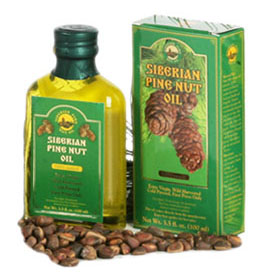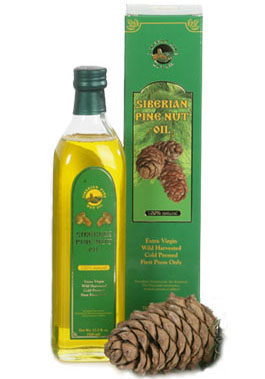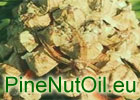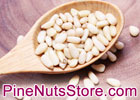BEST PRICE ON THE MARKET. GUARANTEED
"Pine Nut Oil"
PineNutOil.org
 This page is dedicated to the Siberian pine products under brand name "Siberian Pine Nut Oil". Here you can ask your questions, find your answers and read the reviews from people who already used the Siberian pine products under "Siberian Pine Nut Oil" brand.
This page is dedicated to the Siberian pine products under brand name "Siberian Pine Nut Oil". Here you can ask your questions, find your answers and read the reviews from people who already used the Siberian pine products under "Siberian Pine Nut Oil" brand.
Frequently asked questions
Articles
Recipes
Pine nuts
Pine nut oil
Nutrition chart
Store
Customers' Feedback
The brand name "Siberian Pine Nut Oil" stands for business integrity, decency and the highest possible quality of product. All products marketed under this brand name convey the primordial power of Nature and the warmth of our hearts. We offer:
- A variety of high-quality pine products, including pine nuts, pine flour and pine nut oil.
Huge plantations of pine trees grow in the Siberian taiga, said to be the ecologically purest area of the world. The virgin forest of the taiga has never been treated with any chemicals or artificial fertilisation, nor abused by agricultural machines.
Pine nuts (the seeds of the pine tree) take two years to mature, during which time the tree accumulates a huge volume of positive cosmic energy. Crops of nuts are harvested manually by people lovingly devoted to this task, working in a pleasant environment without undue haste to create unique products full of positive energy reflecting the infinite powers of Nature. Specific preparations include:
- We pick only pine cones which fall naturally from the trees, thus ensuring that only ripe cones are selected. We always avoid hitting the trees to shake unripe pine cones down (as happens with some other commercial operations) - a practice which causes the nuts to lose their healing power.
- Cones are then manually shelled with the help of wooden shell-removers. Nut centres are separated from their shells using wooden rollers.
Pine nut oil and pine nut flour marketed under our brand name are obtained by the cold-pressure method, using manual wooden oil-presses.
- Pine nut oil is then stored in special containers and packed in a small village near Almaty city using unique technology to avoid any contact with metal. The whole process is strictly supervised to ensure it complies with all sanitary requirements.
- Final products are placed in special packaging to prevent daylight penetration, and stored at a temperature of 0°C to +5°C to better preserve the product's natural components. The resulting product is a bright gold-coloured liquid with the pleasant smell of pine nuts. It is a 100% natural product with strong healing powers.
Special steps have been taken to protect "Siberian Pine Nut Oil" pine nut oil against counterfeit: Read more about Anti-Counterfeit
Pine nuts are praised throughout the world as a nutritious healthy snack and essential ingredient in multiple oriental and Mediterranean dishes. In fact, pine nuts are so nutritious they have been the staple in diet of many Native American tribes and indigenous people of Siberia (see the nutrition chart below). There are over 20 pine tree species in the world producing pine nuts, of which the pine nuts of Siberian pine (or Siberian pine, Pinus sibirica) are recognized as the most nutritious. These are the pine nuts that are marketed under "Siberian Pine Nut Oil" brand. We have them both shelled (ready to eat) and in the shell. While extracting these pine nuts is a meditative time-consuming process, the rewards are great as well - freshly shelled pine nuts have some volatile essential oils (giving them an additional crisp fragrance of pine needles and a unique taste) which evaporate within one hour after the nuts are shelled.
 Siberian pine nuts contain about 60% oil. They are therefore pressed to obtain pine nut oil, which is available on the market as a very expensive gourmet cooking oil. Cold pressing in all-wooden presses is preferred to retain the nutritional properties of nuts and derive the oil of highest quality.
Siberian pine nuts contain about 60% oil. They are therefore pressed to obtain pine nut oil, which is available on the market as a very expensive gourmet cooking oil. Cold pressing in all-wooden presses is preferred to retain the nutritional properties of nuts and derive the oil of highest quality.
The pine nut oil bearing "Siberian Pine Nut Oil" brand comes exclusively from wild-harvested Siberian pine nuts (Pinus Sibirica species of tree) - one of the most nutritious pine nuts in the world. In comparison, other pine nut oils are usually pressed from the Italian pignolia pine nuts, which are not nearly as potent and are often harvested from trees growing in plantations. Our Siberian pine nut oil is extra virgin (100% cold pressed from freshly shelled raw Siberian pine nuts), whereas most pine nut oils on the market are either not cold pressed or even pressed from roasted (!) pine nuts, which significantly decreases the oil value. Finally, "Siberian Pine Nut Oil" Siberian pine nut oil is the only one which is available on the market anywhere in the world pressed with wooden presses in accordance with traditional techniques. In contrast, all other pine nut oils are pressed using steel presses, which immediately degrades them (contact with steel oxidizes some of the pine nut oil's most important ingredients such as vitamins, and is known to remove the 'life force' from the oil).
Pine nut oil has also traditionally been used in ancient Slavic and European natural medicine to cure a wide array of ailments - ingested (decreasing blood pressure, boosting immune system resistance, etc.) or applied externally (a range of dermatological disorders).It is also used in expensive cosmetics.
Pine nut oil contains pinolenic acid, a polyunsaturated fatty acid,
and is marketed in the U.S. as a means
stimulate cell proliferation, prevent hypertension, decrease blood lipid and blood sugar, and inhibit allergic reactions.
Check out our Recipes section for incredible culinary suggestions featuring the virgin cold-pressed pine nut oil.
The unique Siberian pine nut oil bearing "Siberian Pine Nut Oil" brand is available from www.SiberianSiberianPineNutOil.org on-line Store. It has a shelf life of 12 months (refrigerated).
Nutrient Analysis Source: Custom
1 Yield: (28.000 gram(s))
No. Ingredients: 1
Category: Basic Food
Manufacturer: (None)
Nutrient Goal Template: DAILY VALUES/RDI - ADULT/CHILD
Percentage of Kcals
Protein 10.0%
Carbohydrate 6.2%
Fat, total 83.8%
Alcohol 0.0%
Table prepared by First DataBank Nutritionist Proâ„¢
| Nutrient | Value | Unit | Goal | % |
|---|---|---|---|---|
| Weight | 28.000 | g | ||
| Kilocalories | 186.760 | kcal | 2000.000 | 9 % |
| Protein | 1.904 | g | 50.000 | 4 % |
| Carbohydrate | 1.176 | g | 300.000 | 0 % |
| Fat, Total | 7.056 | g | 65.000 | 11 % |
| Alcohol | 0.000 | g | ||
| Cholesterol | 0.000 | mg | 300.000 | 0 % |
| Saturated Fat | 2.626 | g | 20.000 | 13 % |
| Monounsaturated Fat | 6.424 | g | ||
| Polyunsaturated Fat | 7.187 | g | ||
| MFA 18:1, Oleic | 6.028 | g | ||
| PFA 18:2, Linoleic | 6.967 | g | ||
| PFA 18:3, Linolenic | 0.220 | g | ||
| PFA 20:5, EPA | ||||
| PFA 22:6, DHA | ||||
| Trans Fatty Acid | ||||
| Sodium | 20.160 | mg | 2400.000 | 1 % |
| Potassium | 175.840 | mg | 3500.000 | 5 % |
| Vitamin A (RE) | 0.840 | RE | ||
| Vitamin A (IU) | 8.120 | IU | 5000.000 | 0 % |
| Vitamin A (RAE) | 0.280 | µg | ||
| Beta-Carotene | ||||
| Alpha-Carotene | ||||
| Lutein (+ Zeaxanthin) | ||||
| Beta-Cryptoxanthin | ||||
| Lycopene | ||||
| Vitamin C | 0.560 | mg | 60.000 | 1 % |
| Calcium | 2.240 | mg | 1000.000 | 0 % |
| Iron | 0.857 | mg | 18.000 | 5 % |
| Vitamin D (ug) | 0.000 | µg | 10.000 | 0 % |
| Vitamin D (IU) | 0.000 | IU | 400.000 | 0 % |
| Vitamin E (mg) | 20.000 | |||
| Vitamin E (IU) | 30.000 | |||
| Alpha-Tocopherol | ||||
| Thiamin | 0.348 | mg | 1.500 | 23 % |
| Riboflavin | 0.062 | mg | 1.700 | 4 % |
| Niacin | 1.224 | mg | 20.000 | 6 % |
| Pyridoxine (Vitamin B6) | 0.031 | mg | 2.000 | 2 % |
| Folate (Total) | 16.240 | µg | 400.000 | 4 % |
| Folate (DFE) | 16.240 | µg | ||
| Cobalamin (Vitamin B12) | 0.000 | µg | 6.000 | 0 % |
| Biotin | 300.000 | |||
| Pantothenic Acid | 0.059 | mg | 10.000 | 1 % |
| Vitamin K | 80.000 | |||
| Phosphorus | 9.800 | mg | 1000.000 | 1 % |
| Iodine | 150.000 | |||
| Magnesium | 65.520 | mg | 400.000 | 16 % |
| Zinc | 1.198 | mg | 15.000 | 8 % |
| Copper | 0.290 | mg | 2.000 | 14 % |
| Manganese | 1.213 | mg | 2.000 | 61 % |
| Selenium | 70.000 | |||
| Fluoride Chromium | 0.120 | |||
| Molybdenum | 75.000 | |||
| Dietary Fiber, Total | 2.996 | g | 25.000 | 12 % |
| Soluble Fiber | ||||
| Insoluble Fiber | ||||
| Crude Fiber | ||||
| Sugar, Total | ||||
| Glucose | ||||
| Galactose | 0.000 | g | ||
| Fructose | ||||
| Sucrose | ||||
| Lactose | 0.000 | g | ||
| Maltose | ||||
| Sugar Alcohol | ||||
| Other Carbohydrate | ||||
| Tryptophan | 40.880 | mg | ||
| Threonine | 102.760 | mg | ||
| Isoleucine | 126.000 | mg | ||
| Leucine | 233.520 | mg | ||
| Lysine | 121.520 | mg | ||
| Methionine | 57.960 | mg | ||
| Cystine | 58.800 | mg | ||
| Phenylalanine | 124.040 | mg | ||
| Tyrosine | 118.720 | mg | ||
| Valine | 167.440 | mg | ||
| Arginine | 630.280 | mg | ||
| Histidine | 77.560 | mg | ||
| Alanine | 169.400 | mg | ||
| Aspartic Acid | 295.120 | mg | ||
| Glutamic Acid | 551.320 | mg | ||
| Glycine | 164.920 | mg | ||
| Proline | 174.160 | mg | ||
| Serine | 137.480 | mg | ||
| Moisture | 1.652 | g | ||
| Ash | 0.633 | g | ||
| Caffeine | 0.000 | mg |
Friday, September 01, 2006 First DataBank Nutritionist Proâ„¢
g = gram; mg = milligram; mcg = microgram; IU = International Units






